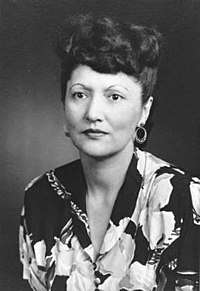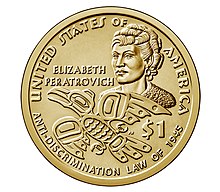Elizabeth Peratrovich
Elizabeth Jean Peratrovich (/ˈprætəvɪtʃ/; July 4, 1911 – December 1, 1958), was an American civil rights activist who worked on behalf of equality for Alaska Natives. In the 1940s, she was credited with advocacy that gained the passage of the territory's Anti-Discrimination Act of 1945, the first anti-discrimination law in the United States. In March 2019, her obituary was added to The New York Times as part of their "Overlooked No More" series.[1]
Elizabeth Peratrovich | |
|---|---|
 | |
| Born | July 4, 1911 |
| Died | December 1, 1958 (aged 47) Seattle, Washington, U.S. |
| Other names | Kaaxgal.aat |
| Education | Sheldon Jackson College Western College of Education |
| Spouse(s) | Roy Peratrovich (1908–1989, m. 1931) |
| Children | Roy Peratrovich, Jr. (b. 1934) Frank Allen Peratrovich (1937–2010) Loretta Marie Montgomery (1940–2010) |
| Parent(s) | Andrew and Mary Wanamaker |
Early life and education
Elizabeth Peratrovich was born on July 4, 1911 in Petersburg, Alaska,[2] and was a member of the Lukaax̱.ádi clan, in the Raven moiety of the Tlingit nation. She was orphaned at a young age and adopted by Andrew and Mary Wanamaker.[3][4] Andrew was a fisherman and Presbyterian lay minister. Elizabeth grew up with them in Petersburg, Klawock, and Ketchikan, Alaska, and graduated from Ketchikan High School. She attended Sheldon Jackson College in Sitka, and the Western College of Education in Bellingham, Washington (now part of Western Washington University).[lower-alpha 1]
Activism
In 1941, while living in Juneau, the Peratroviches found more discrimination, having difficulty finding housing and seeing signs banning Native entry to public facilities. They petitioned the territorial governor, Ernest Gruening, to ban the "No Natives Allowed" signs then common at public accommodations in that city and elsewhere. The Anti-Discrimination Act was defeated by the territorial legislature in 1943. As leaders of the Alaska Native Brotherhood and the Alaska Native Sisterhood, the Peratroviches lobbied the territory's legislators and represented their organizations in their testimony.
Elizabeth Peratrovich was the last to testify before the territorial Senate voted on the bill in 1945, and her impassioned testimony was considered decisive.[6]
I would not have expected that I, who am barely out of savagery, would have to remind gentlemen with five thousand years of recorded civilization behind them, of our Bill of Rights.[7]
She was responding to earlier comments by territorial senator Allen Shattuck of Juneau. He had earlier asked, "Who are these people, barely out of savagery, who want to associate with us whites, with 5,000 years of recorded civilization behind us?"[8] The Senate voted 11-5 for House Resolution 14, providing "...full and equal accommodations, facilities, and privileges to all citizens in places of public accommodations within the jurisdiction of the Territory of Alaska; to provide penalties for violation."[8] The bill was signed into law by Governor Gruening, nearly 20 years before the US Congress passed the Civil Rights Act of 1964. Acts of the territorial legislature required final approval from the U.S. Congress, which affirmed it. (Bob Bartlett was noted for his efficiency in that regard.)
Fran Ulmer, who represented Juneau in the Alaska House of Representatives (and who later became lieutenant governor of Alaska), in 1992 said the following about Peratrovich's testimony:
She talked about herself, her friends, her children, and the cruel treatment that consigned Alaska Natives to a second-class existence. She described to the Senate what it means to be unable to buy a house in a decent neighborhood because Natives aren't allowed to live there. She described how children feel when they are refused entrance into movie theaters, or see signs in shop windows that read "No dogs or Natives allowed".[7]
Personal life
On December 15, 1931, Elizabeth married Roy Peratrovich (1908–1989), also a Tlingit, of mixed native and Serbian descent who worked in a cannery. They lived in Klawock, where Roy was elected to four terms as mayor.
Looking for greater opportunities for work and their children, they moved to Juneau, where they found more extensive social and racial discrimination against Alaska Natives. They had children: daughter Loretta, and sons Roy, Jr. and Frank.[8]
The Peratrovich family later moved to Antigonish, Nova Scotia, Canada, where Roy pursued an economics degree at St. Francis Xavier University. From there they moved to Denver, Colorado, where Roy studied at the University of Denver. In the 1950s, the Peratroviches moved to Oklahoma, and then back to Alaska.
Elizabeth Peratrovich died of cancer on December 1, 1958. She is buried at Evergreen Cemetery, Juneau, Alaska alongside her husband Roy.
Son Roy Peratrovich, Jr., became a noted civil engineer in Alaska. He designed the Brotherhood Bridge in Juneau, which carries the Glacier Highway over the Mendenhall River.
Legacy and honors

- On February 6, 1988, the Alaska Legislature established February 16 (the day in 1945 on which the Anti-Discrimination Act was signed) as "Elizabeth Peratrovich Day", in order to honor her contributions: "for her courageous, unceasing efforts to eliminate discrimination and bring about equal rights in Alaska" (Alaska Statutes 44.12.065).
- The Elizabeth Peratrovich Award was established in her honor by the Alaska Native Sisterhood.
- In 1992, Gallery B of the Alaska House of Representatives chamber in the Alaska State Capitol was renamed in her honor.[7] Of the four galleries located in the respective two chambers, the Peratrovich Gallery is the only one named for someone other than a former legislator (the other House gallery was named for Warren A. Taylor; the Senate galleries were named for former Senators Cliff Groh and Robert H. Ziegler).
- In 2003, a park[9] in downtown Anchorage was named for Elizabeth and Roy Peratrovich. It encompasses the lawn surrounding Anchorage's former city hall, with a small amphitheater in which concerts and other performances are held.[10]
- In 2009, a documentary about Peratrovich's groundbreaking civil rights advocacy premiered on October 22 at the Alaska Federation of Natives convention in Anchorage. Entitled For the Rights of All: Ending Jim Crow in Alaska, the film was scheduled to air as a PBS documentary film in November 2009. The film was produced by Blueberry Productions, Inc. and was primarily written by Jeffry Lloyd Silverman of Anchorage.[11]
- In 2017, the theater in Ketchikan's Southeast Alaska Discovery Center was named in honor of Elizabeth Peratrovich, and a companion exhibit exploring her role in the struggle for Alaska Native civil rights was unveiled.[12]
- In 2018, Elizabeth Peratrovich was chosen by the National Women's History Project as one of its honorees for Women's History Month in the United States.[13]
- On October 5, 2019, United States Mint Chief Administrative Officer Patrick Hernandez announced that Peratrovich would appear on the reverse of the 2020 Native American $1 Coin.[14][15]
- In December, 2019, a 4-story apartment building called Elizabeth Place, named after Peratrovich, opened in downtown Anchorage.
Citations
- "Super race theory hit at hearing". The Alaska Daily Empire. Juneau: Helen Troy Monsen. February 6, 1945. p. 8. Retrieved November 18, 2011.
Footnotes
Notes
- Link to 1930 census of Klawock showing the Wanamaker household starting on line 18.[5]
References
- "Overlooked No More: Elizabeth Peratrovich, Rights Advocate for Alaska Natives". The New York Times. 2019-03-20. ISSN 0362-4331. Retrieved 2019-04-01.
- Duncan, Pauline (1999). Elizabeth Peratrovich: Native Civil Rights Leader. Sitka: Children of the Tidelands Publishing. p. 3.
- Elizabeth Peratrovich 100 Years, Alaska Newspapers, 4 July 2011
- Andrew J. Wanamaker, Chalyee éesh and Wooshkeenaa, of the Kaagwaantaan clan, Eagle Nest House; Mary Wanamaker; and daughter, Elizabeth Peratrovich. Alaska State Library.
- "Intellectual Reserve, Inc". FamilySearch.org. Retrieved 2011-10-25.
- Monsen, Helen Troy (6 February 1945). "Super race theory hit at hearing". The Alaska Daily Empire. Juneau. p. 8. Retrieved 18 November 2011.
- Ulmer, Fran (May 1, 1992). "Honoring Elizabeth Wanamaker Peratrovich". Alaska House of Representatives. Anchorage: University of Alaska Anchorage Institute of Social and Economic Research. Retrieved October 25, 2011.
- "A Recollection of Civil Rights Leader: Elizabeth Peratrovich, 1911-1958", Alaskool, accessed 25 October 2011
- "Elizabeth & Roy Peratrovich Park" (PDF). Municipality of Anchorage. Archived from the original (PDF) on 8 December 2015. Retrieved 30 January 2017.
- "Projects Archive - Flight of the Raven". Anchorage Park Foundation. Anchorage. Archived from the original on April 25, 2012. Retrieved October 26, 2011.
- For the Rights of All: Ending Jim Crow in Alaska, Alaska Civil Rights Organization, accessed 25 October 2011
- Theater Named for Peratrovich. Bowman, Nick. Associated Press/Ketchikan Daily News, Feb. 25, 2017.
- "National Women's History Month: What is it, when did it begin, who is being honored this year?". kiro7.com. 25 February 2018.
- United States Mint. "United States Mint Unveils 2020 Native American $1 Coin Reverse Design". United States Mint. Retrieved 7 October 2019.
- Leval, Dave (October 6, 2019). "First Alaska Native on US currency revealed as Alaska Native Heritage Month becomes official". Anchorage, Alaska: KTVA. Retrieved 2020-01-03.
Further reading
- Dauenhauer, Nora ; Dauenhauer, Richard (ed). (1994) "Haa k̲usteeyí", our culture : Tlingit life stories. Seattle; Juneau : University of Washington Press ; Sealaska Heritage Foundation. ISBN 0295974001.
- Roy Scott Peratrovich, Sr. ; Roy Peratrovich. (2001) A recollection of civil rights leader Elizabeth Peratrovich, 1911-1958. Alaska? : R.A. Peratrovich. OCLC 274035724.
- Peratrovich, Elizabeth W. American Indian biographies. Carole Barrett, Harvey Markowitz (ed.) ; project editor, R. Kent Rasmussen. (c2005). Pasadena, Calif. : Salem Press, Magill's choice. Rev. ed. ISBN 1587652331, 9781587652332. Table of contents.
- Peck, David R. ; Irons-Georges, Tracy. (2000) American ethnic writers, Magill's choice. LCCN 00059529, DOI 810.9/920693. ISBN 0893561576 (set), 089356172X (v.1), 0893561843 (v.2)
- Cochrane, Marjorie (2014). Bold women in Alaska history. Missoula, Montana : Mountain Press Publishing Company. ISBN 9780878426171. LCCN 2014014828.
- No small lives : handbook of North American early women adult educators, 1925-1950. Susan Imel, (The Ohio State University) ;Gretchen T. Bersch, (University of Alaska Anchorage) (ed). Charlotte, North Carolina : Information Age Publishing, Inc., 2015. ISBN 9781623968830, 9781623968847. LCCN 2014039819.
- Say we are nations : documents of politics and protest in indigenous America since 1887. Daniel M. Cobb (ed) (2015). Chapel Hill : The University of North Carolina Press. ISBN 9781469624808. LCCN 2015010506.
- Edwards, Erika. Raymond Bial (ed). (2017). The people and culture of the Tlingit. New York : Cavendish Square Publishing. ISBN 9781502622518. LCCN 2016038578.
- Clinton, Hillary Rodham ; Chelsea Clinton. (2019) The book of gutsy women. New York : Simon & Schuster. ISBN 9781501178412, 1501178415 (ebook). LCCN 2019946643. First Simon and Schuster hardcover.
- Boochever, Annie ; Roy Peratrovich, Jr. (2019) Fighter in velvet gloves : Alaska civil rights hero Elizabeth Peratrovich. Fairbanks : University of Alaska Press. ISBN 9781602233706, 9781602233720 (e-book). LCCN 2018028794. LCCN 2018049028 (e-book).
External links
- Alaska Civil Rights For All official site